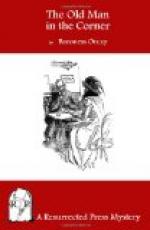“It presented itself in the person of Mr. Campbell’s clerk, who, before the Procurator Fiscal, had corroborated his employer’s evidence in every respect. In Scotland no witness in any one case is present in court during the examination of another, and Mr. Macfarlane, the clerk, was, therefore, quite unprepared for the pitfalls which Sir James Fenwick had prepared for him. He tumbled into them, head foremost, and the eminent advocate turned him inside out like a glove.
“Mr. Macfarlane did not lose his temper; he was of too humble a frame of mind to do that, but he got into a hopeless quagmire of mixed recollections, and he too left the witness-box quite unprepared to swear as to the day of the interview with the lady with the diamond earrings.
“I dare say, mind you,” continued the man in the corner with a chuckle, “that to most people present, Sir James Fenwick’s cross-questioning seemed completely irrelevant. Both Mr. Campbell and his clerk were quite ready to swear that they had had an interview concerning some diamond earrings with a lady, of whose identity with the accused they were perfectly convinced, and to the casual observer the question as to the time or even the day when that interview took place could make but little difference in the ultimate issue.
“Now I took in, in a moment, the entire drift of Sir James Fenwick’s defence of Edith Crawford. When Mr. Macfarlane left the witness-box, the second victim of the eminent advocate’s caustic tongue, I could read as in a book the whole history of that crime, its investigation, and the mistakes made by the police first and the Public Prosecutor afterwards.
“Sir James Fenwick knew them, too, of course, and he placed a finger upon each one, demolishing—like a child who blows upon a house of cards—the entire scaffolding erected by the prosecution.
“Mr. Campbell’s and Mr. Macfarlane’s identification of the accused with the lady who, on some date—admitted to be uncertain—had tried to sell a pair of diamond earrings, was the first point. Sir James had plenty of witnesses to prove that on the 25th, the day after the murder, the accused was in London, whilst, the day before, Mr. Campbell’s shop had been closed long before the family circle had seen the last of Lady Donaldson. Clearly the jeweller and his clerk must have seen some other lady, whom their vivid imagination had pictured as being identical with the accused.
“Then came the great question of time. Mr. David Graham had been evidently the last to see Lady Donaldson alive. He had spoken to her as late as 8.30 p.m. Sir James Fenwick had called two porters at the Caledonian Railway Station who testified to Miss Crawford having taken her seat in a first-class carriage of the 9.10 train, some minutes before it started.
“‘Was it conceivable, therefore,’ argued Sir James, ’that in the space of half an hour the accused—a young girl—could have found her way surreptitiously into the house, at a time when the entire household was still astir, that she should have strangled Lady Donaldson, forced open the safe, and made away with the jewels? A man—an experienced burglar might have done it, but I contend that the accused is physically incapable of accomplishing such a feat.




